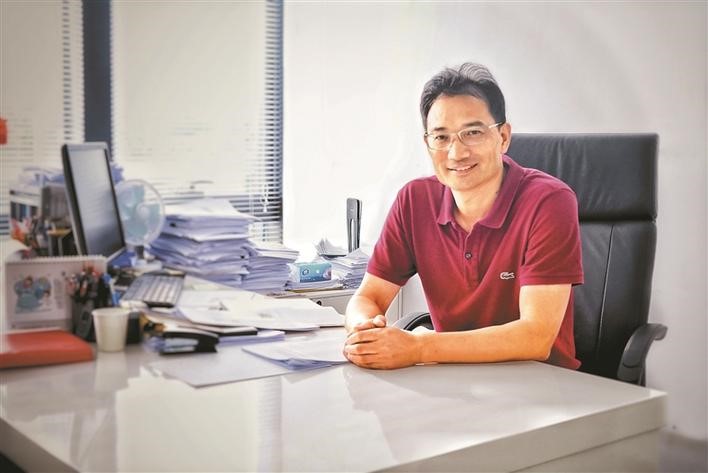News
Efforts to conquer leukemia - Interview with Yihan Wang, founder of Shenzhen TargetRx Inc.
2018-09-29 Views:
Huizhong Gu, Securities Times reporter, September 29, 2018,
Source: Securities Times
Website: http://www.southmoney.com/caijing/gongsixinwen/201809/2621820.html

The movie Dying to Survive allowed the public to learn about chronic myelogenous leukemia and Gleevec. In fact, leukemia is the cancer with the best therapeutic effect and has the highest survival rate. This is owing to the contribution of Yihan Wang. Yihan Wang worked in the pharmaceutical company Ariad in Boston, USA for 16 years. Together with his team, he developed the third-generation drug Ponatinib for the treatment of chronic myelogenous leukemia, which solved the resistance problem of Gleevec.
In 2014, he returned to Shenzhen to establish TargetRx Inc., and led a young team to develop the fourth-generation drugs for the treatment of for chronic myeloid leukemia, and strive to cure the disease.
It took 16 years to develop the third-generation drug for leukemia
Yihan Wang was born from a poor family in a rural area in Hubei. Since he was a child, he was encouraged by his family to study hard to change his destiny. After graduating from junior high school, he was admitted to Jingzhou Middle School in Hubei Province with the second place in Jingzhou area. After graduating from high school, he was admitted to the University of Science and Technology of China. He entered New York University in 1992 and joined Ariad after graduating with a PhD in Chemistry in 1997 and worked until 2013.
The emergence of Gleevec not only allowed 89% of patients to live for more than 5 years, but after 5 years, 98% of patients with chronic myelogenous leukemia achieved complete blood remission. However, with the long-term use of Gleevec by patients, some patients have gradually discovered that the "magic drug" is no longer useful, and the condition has deteriorated again, that is, the problem of drug resistance has appeared. In 1997, Ariad decided to develop the third-generation drug for chronic myelogenous leukemia to solve the resistance problem of Gleevec. However, the drug development took 16 years, which was a long arduous and tortuous story. Yihan Wang told the reporter that there was no progress in the first few years. Around 2000, the cooperation with major German pharmaceutical companies was also announced to be terminated. Funds were almost exhausted and the company had to lay off a large number of employees. Some colleagues chose to leave because they lost confidence in the project. He said that at that time the company and his career had fallen to the bottom.
A year later, they shifted the direction of development to the structural design of the newly emerging kinase catalytic active domain, using structural elements that are not commonly used by pharmaceutical chemists. “At the initial design, we were not sure whether it would be chemically stable enough, but after several rounds of optimization, the results were unexpectedly good, and the molecule fully achieved our design goals. The molecular structure is quite stable and closely complexed with kinases, making the molecule highly active against cancer cells.” Through innovative research and development, their third-generation anti-chronic leukemia drug ponatinib was succeeded.
The top American cancer journal Cancer Cell once used their design as the cover story. Yihan Wang said, “This can be regarded as a textbook case of modern new drug development. Everyone in our team is very proud of this.”
Returning to China to start a business to develop first-in-class drugs for China
In the movie Dying to Survive, the patient had to take a huge risk to buy "magic drug" in India in order to survive. In reality, some patients even directly buy the active intermediates of the drugs and make the raw materials into preparations. After the doctor told them that there was no drug available, they had to take the drug under clinical trial in order to survive.
Hearing too many of these stories, Yihan Wang feels that only by developing China's own first-in-class drugs, the shortage of life-saving drugs can be fundamentally solved. Therefore, in 2013, he made up his mind to resign from Ariad and returned to China to start a business. In 2014, TargetRx Inc. was founded in Shenzhen. Different from other overseas returnees to start businesses in China, TargetRx has been developing the first-in-class drugs, instead of the manner of in-license. At the same time, TargetRx also pays great attention to patent application to protect its intellectual property rights. In the past four years, since its establishment, the company has applied for nearly 80 first-in-class drug patents. This speed has made TargetRx's R&D efficiency rank among the best among large and small pharmaceutical companies in China.
After returning to China, Yihan Wang focused on chronic myelogenous leukemia. On the one hand, he has nearly two decades of accumulation in this field. On the other hand, the treatment of chronic myelogenous leukemia is the pioneer in the R&D of targeted anti-cancer drugs, and any breakthrough is of indicator significance. Considering that ponatinib can only extend the life of the patient. So far, chronic myelogenous leukemia cannot be cured. The long-term use of expensive anticancer drugs has brought a heavy financial burden to the patient’s family, so ambition of TargetRx is to cure chronic myelogenous leukemia to solve the patient's worries once and for all.
At present, TargetRx has made breakthrough progress in research and development. At present, the best compound has an order of magnitude improvement over the activity of ponatinib. This helps a deeper molecular response to eliminate residual lesions, which are the prerequisites for achieving a cure for chronic myelogenous leukemia. Although the drug needs to be confirmed by clinical trials, Yihan Wang is very confident in achieving the final goal. Currently, they are preparing for pre-clinical application.
R&D of new drugs requires courageous exploration
Looking back on his journey, Yihan Wang said, “I have been working in the development of new drugs for more than 20 years and I am honored to have achieved some results.” However, humans have so far discovered more than 7,000 genetic diseases and orphan diseases, but only more than 300 drugs are used for treatment, and the gap is as high as 95%. The remaining 95% of patients also need help, and there are still many new drug discovery tasks to do. Even these 300 drugs have been discovered, many of which are slightly better than placebo, and there is a lot of room for improvement.
According to his observations, modern drug design actually has great limitations. For example, most drugs only have four elements: C, H, O, and N, while there are 118 elements on the periodic table, most of them are rarely tried. In addition, the structural elements in the designed drugs are only limited to those common and predictable groups. They successfully developed ponatinib and brigatinib because they broke through the tradition. He said that TargetRx encourages R&D personnel to seek breakthroughs and explore the unknown courageously. Innovation is the source of our life, only innovation can find more and better life-saving drugs for patients.
Yihan Wang said that when he discovered a brand-new structure designed to effectively treat cancer and save lives, the sense of accomplishment could not be expressed in words. He believes that as long as they really work hard, focus and persevere, pharmaceutical scientists can develop good drugs that can cure diseases and save people. The field of first-in-class drugs in China is in a very good era, and the development will become faster and faster.







 Tel: +86-0755-86934300
Tel: +86-0755-86934300 3rd Floor, Building A1, Kexing Science Park, No. 15 Keyuan Rd., Nanshan District, Shenzhen, China
3rd Floor, Building A1, Kexing Science Park, No. 15 Keyuan Rd., Nanshan District, Shenzhen, China E-mail:
E-mail: 